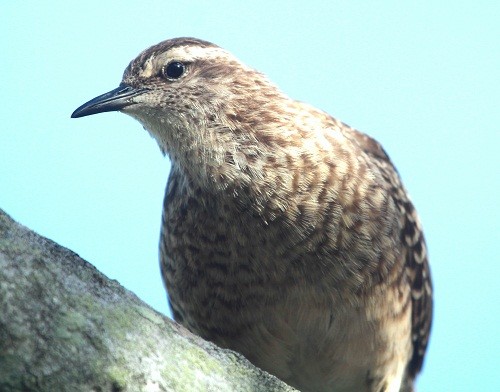Titi forever
Most of the world's sandpiper species migrate thousands of kilometres between Arctic breeding grounds and subtropical wintering grounds, but in the not-too-distant evolutionary past, one group gave up this habit and went native in French Polynesia. The Endangered Tuamotu Sandpiper, Prosobonia cancellata, known locally as the Titi, is the only surviving representative of a group of at least six species that became full-time residents in this region. The other species were extirpated with the arrival of first Polynesians, and later Europeans, and their small-mammal associates. Approximately 1,000 Titi remain, limited to four rat-free or partially rat-free atolls.
In 2008 Marie-Helene Burle from Simon Fraser University, aided by the Ornithological Society of French Polynesia (SOP-MANU — BirdLife in French Polynesia), began an intensive graduate research project on this previously unstudied species, working largely in isolation on uninhabited atolls. Her first five-month field season was followed by a second in 2010, and she is currently halfway through a lengthy third, which began as she joined a expedition organised by SOP-MANU to visit two of the additional three atolls where Titi remain. Marie and her collaborators have discovered remarkable adaptations of this bird to its tropical lifestyle. In sharp contrast to similar-sized migrant shorebirds such as Wandering Tattler, which share the same atolls when not breeding, the Titi is not a bird of the beach or rocky intertidal areas, favouring instead semi-open vegetated areas. "One reason for this is their reliance on feeding on nectar from flowers, a unique food source for a member of this group," said Marie. "Functional morphologists have shown that the bird's tongue is forked, which may allow it to obtain nectar more efficiently."

Tuamotu Sandpiper on Morane (Thomas Ghestemme).
Marie captured and marked nearly all of the birds on two atolls, and documented their social system. Breeding birds live in pairs on quite small territories (e.g. 20×30m). Marie's work has sparked others to make observations of the species, and Francis Gazeau discovered that Titi sometimes nest in trees as well as on the ground. Females lay two eggs per clutch, rather than the four laid by Arctic-breeding sandpipers. Many eggs disappear, at least some of them taken by Coconut Crabs, as caught on video. Marie took the first photographs ever taken of newly hatched chicks, which had never previously been described. Sadly, the chicks have extremely low survival — most starve to death. "We speculate that overcrowding in the very few areas where the birds can breed has lead to food shortages and low fledging success," said Marie.
Towards the end of Marie's second field season, during a very dry season, a wind-driven swell event caused saltwater to wash over parts of the atolls. About a month later, she realised that many of the birds were dying, as were other landbirds such as Spotted Crake. She believes that saltwater intrusion and a lack of rain stressed vegetation, resulting in starvation. About half the birds at her main study site died, and a year later there has not been a rebound of the population. The high mortality associated with a local swell event highlights the vulnerability of local populations, which would also be threatened should Black Rats establish themselves on their four remaining refuges. Marie also worked with staff from Island Conservation to eradicate rodents from a small islet within an atoll which holds rats. "We are waiting to learn whether Titi are now breeding on this rat-free site," said Marie. "For the longer term, however, the species' future relies on reintroducing it to more distant sites where independent populations can thrive."
Marie and her colleagues are preparing a survey of potential reintroduction sites. Their experience working with the birds, and the knowledge they have obtained about their feeding and breeding ecology and predators, provide a sound basis for translocation planning. Building on the success of groups that have removed rats from several islands or atolls, we believe that, for this one species at least, meaningful conservation measures can be taken at modest additional cost, to substantially decrease the likelihood of its extinction. "We are hopeful that we will help ensure the presence of Titi forever," concluded Marie.

